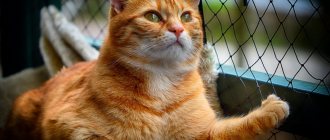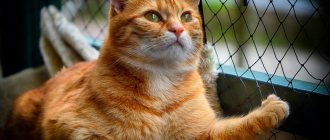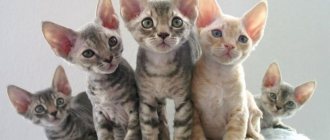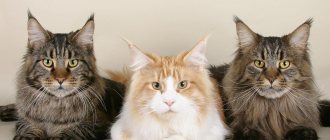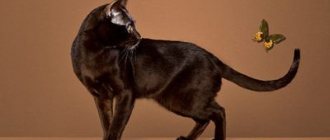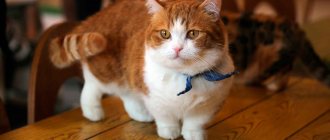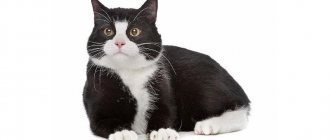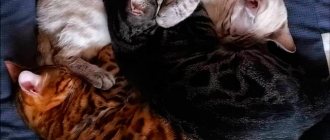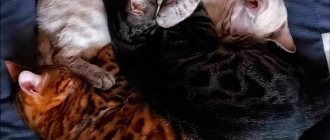What kind of breed, how did it come about?
Tiger cats are very interesting and mysterious creatures. Thanks to their unusual coat color, some of them resemble small tigers, others resemble leopards and even jaguars. Some tiger breeds have remained alive in the wild, but the majority have long been domesticated. There are also artificially created breeds that are quite expensive. Next we will talk about the most common breeds of tiger cats.
Tiger cats (lat. Leopardus) are a genus of the cat family, the order of carnivores. The Latin name of the genus has nothing to do with leopards; tiger cats are classified as a subfamily of small cats. They are distinguished by gray or yellowish-brown fur, which necessarily has patterns in the form of stripes or black spots. All representatives of this genus live in the New World, most of all in Central and South America.
The tiger genus dates back a very long time. These were wild cats that lived in different parts of the world. And today some representatives of the genus remain among the wild. But there are varieties created artificially.
Why a purebred pet?
Choosing a pet is not an easy task. Nowadays it has become popular to purchase purebred cats. Each breed is beautiful and graceful in its own way, plus, with such a cat you can take pride of place at the exhibition. But you shouldn’t judge a cat by its appearance, it should suit your style and lifestyle. The catalog contains a lot of useful information about animals: appearance, temperament, necessary care. Representatives of the Persian and Angora breeds require special care, but they are not so dependent on human interaction. Are you at home most of the time and want some fun? Buy a Siamese or Abyssinian cat. If you have small children at home, you need a pet with a lot of patience in order to withstand all this squeezing. A British or Scottish cat would be a good nanny.
Diversity of the cat world
The world of cats is diverse. They differ in color, eye shape, fur length, character and other equally important criteria. There are a large number of organizations involved in developing standards and registering breeds. How a relationship develops with a pet depends on the person. For a cat, the owner is the most adored person on earth; his betrayal will leave a scar on the animal’s soul. For humans, a cat is a healing salvation from depression and bad mood, a fluffy little ball that can warm the heart on the coldest evenings.
Appearance
Externally, cats with brindle coloring are very impressive: black stripes or spots adorn the entire body. If you look closely at the photo of these beautiful longhorned beetles, you will notice that they have a rather curious body structure. In general, adult cats and male cats are large, weighing from 6 to 8 kg, have a long thin tail and small paws.
Their muzzle is elongated and has an unusually wide nose. Also, many brindles are characterized by a powerful neck, regular ears and large blue eyes.
Plain (solid)
The color of Scottish Fold cats is monochromatic and they should not have any other color. The fold-eared cat can be of the following colors: white and black, chocolate and lilac, blue and red, cream, fawn and cinnamon. The most popular color in the world among solid Scottish cats is blue. These are the majority of cats.
White
The white Scottish Straight cat can have different eyes, from blue and bright orange to rich amber and copper. Kittens of this variety remain white for the rest of their lives. If kittens have spots, then an adult cat remains white for the rest of its life.
Black
The Scottish Fold black cat is mostly bright in color. A couple of white hairs are acceptable, but if the cat has large red and brown patches, then it is not a purebred.
Black Scottish Fold cats should be bright black in color and their ears, like all fold-eared cats, should be pressed to the head, unlike straight-eared cats. A straight-eared black cat always has its ears erect.
Chocolate
The chocolate Scottish Fold looks impressive. The chocolate color is quite rare. Brown fold kittens should have a smooth, uniform coat of chocolate color. The dark brown coloring adds nobility to the cat.
A brown cat gets this color if he has chocolate, chocolate bicolor or chocolate color points in his pedigree. Chocolate Scottish kittens always delight their owners. They look very cool against a light background.
Lilac (lavender)
A lilac long-eared cat gets this color if he has either lilac color points or lilac in his pedigree. The lilac coloration goes well with orange, copper or amber colored eyes and a light brown nose. This color is also called coffee with milk.
Blue color (blue)
The Scots Blue can have a coat color of many shades of blue. Some cats may have a fur color closer to gray, and some closer to blue. Each hair must be saturated, then the coat will be perfectly blue.
Coat and colors
Today the brindle color is commonly called “tabby”. It covers the entire body of the animal with stripes, like a tiger, or spots, like a leopard. In this case, the main background can be anything.
Most often, tiger cats have fur of a brown or beige background. The stripes on them are brown, dark red or black. Gray and silver representatives, which do not at all look like predators, were also noted. Some brindles can be tortoiseshell or calico in color.
There are cats with a brindle pattern among short-haired and long-haired breeds. Sometimes kittens are born without stripes, but after 2-3 weeks the stripes definitely appear, but the final formation of color sometimes takes months. The brindle color is surprisingly varied and can combine various elements of pattern, background color, spots and stripes. Since the list of all types of this varied color is quite large, we will consider only the most interesting and common breeds of tiger cats.
Asian tabby
The brindle pattern is found among both short-haired and long-haired felines.
The Asian tabby cat is an animal with an exotic tiger color. The color of the coat can reach gray and silver shades, not at all reminiscent of its predatory counterpart. The formation of kittens' coloration can take from several weeks to two to three months. Purchasing an expensive friend is only possible at a specialized breeding farm upon pre-order.
The cost of a pet depends on the pedigree history, color contrast and characteristic pattern. Belonging to a certain class determines the final price. Pet class with differences from the standard color is estimated at 15-30 thousand rubles, Brit class with minimal errors in the standard - from 30-40 without the right and up to 60-70 thousand with the right to further breeding. Show class is a brindle cat with an ideal pattern and the right to breed. It costs from 80 thousand.
On her neck there is a spot - a necklace, and her eyes and nose with mouth are also outlined. The tail is tapered, with ring-shaped spots.
Painting comes with 4 types of patterns:
- spotted;
- marble (with stripes and stains);
- brindle;
- ticked (with a pattern on the face and striped hairs on the body).
Colors range from blue to cream and chocolate. The ears are erect, the eyes are almond-shaped, the irises are golden, and there are cheekbones. The character is friendly, gentle, communicates with people and other inhabitants of the house.
Leopard-colored cats are a mixture of various breeds, including wild ones. The most important thing in communicating with them is to try to find mutual understanding. A close study of your pet will help you find a common language and create comfort for everyone.
Character of domestic "tigers"
Domestic brindle cats are usually calm, self-sufficient, curious, and love attention and affection. From such cats you cannot hear the usual cat meow. The sounds they make are reminiscent of birds chirping. Kittens are very active, playful, and enjoy communicating with everyone who pays attention to them.
Adult animals are smart, tolerant of children, loyal to their owner, not jealous, and get along with other pets: dogs, cats, birds. The black tiger cat lives a long time, does not need special conditions and feels good in a small room. Its lifespan is about twenty years.
Buying a kitten
You can count the number of nurseries that deal only with toygers on one hand. These cats are not always seen even at a large multi-system exhibition. Pre-read about the breed on the Internet, go to the breeders' websites. You need to buy kittens only at 3 months of age (they are sold from 2.5 months). The kitten should already have been dewormed (i.e. given an anthelmintic drug) and vaccinated. Breeders are required to present a veterinary passport (it contains the dates of vaccinations) and birth certificate
Familiarize yourself with the original pedigrees of the parents of the selected kitten and make sure that all its ancestors were of the same breed - toyger. Only in this case can you be relatively calm about his health
Ask about your baby's habits and play with him. A reputable breeder will not sell a toyger without a contract, which will stipulate, for example, mandatory castration/sterilization or participation in exhibitions in the advertising class.
Breeds of cats with brindle color
Tiger "savage" oncilla
This tiger cat still lives in the wild today. The oncilla is larger than the average domestic cat, but among other wild cat breeds it is the smallest representative. As a rule, oncillas have yellow-gray fur with stripes. These “savages” are not afraid of water and swim well.
Externally, the oncilla resembles a miniature jaguar. Its coat is short, on the surface there are characteristic tiger stripes, consisting of spots closed in rings. Habitat: mountain evergreen moist forests of the tropics, eucalyptus thickets and thorny shrubs, savannas, subtropical forests. Oncilla often settles near populated areas, in eucalyptus plantings.
- Dog breeds
- Urban dog breeds
- Origin of the cat
- Hypoallergenic dogs
- Fighting dog breeds
- The rarest cat breeds
It is difficult to distinguish an adult oncilla from a baby jaguar. Their characteristic appearance and beautiful fur attract poachers, as a result of which the oncilla population is gradually declining. The breed is endangered, so hunting for oncills is prohibited in most of their habitat.
Considering the price of the oncilla, as well as its whimsical nature, it is worth considering several times whether you can keep such a wild animal in appropriate conditions so that it not only pleases your eye, but is also quite happy. If you have the opportunity to provide a wild cat with a free enclosure and your care, then you can safely acquire a new friend, because the beauty of its color can amaze anyone.
Toyger - miniature tiger
Many domestic cats have brindle stripes. The most popular brindle pet breed is the toyger. If translated from English, the name means “toy tiger.” This animal is one of the best exotic breeds; its cost is very high. Therefore, it is believed that the presence of a toyger in the house gives it a special chic and is a sign of the owner’s material well-being.
Scientists have been searching for ideal parents for breeding the tiger breed for a long time. As a result, she was created by crossing an ordinary cat and a Bengal cat. But the appearance of the toyger is like that of a real tiger. Only much smaller in size. Outwardly, he looks very graceful and aristocratic.
The body structure of such cats has its own characteristics. They themselves are quite large, their body weight reaches 6-8 kg, but they have a long and thin tail, as well as small paws. The toyger has an elongated muzzle and a wide nose, which is unusual for ordinary cats. The pet has a powerful neck, small ears and large blue eyes.
Tiger stripes on the body can be of different shades - black, yellow, brown. The paws and tip of the tail are always black. Such animals are short-haired. As for character, the brindle cat is very affectionate, calm, and loves to be given a lot of attention. It is worth noting that toygers make not only standard cat sounds, but others that are similar to bird sounds. Little kittens are active and playful. Adult pets are calmer, smarter, and devoted to their owner.
In addition, the black tiger cat lives quite a long time. Its lifespan can reach 20 years.
Bengal cat - domestic leopard
This cat breed is quite rare and is also of artificial origin. Bengal cats were created in 1963 in California by crossing wild leopard cats with domestic cats. Long-term work on the breed and use in breeding other breeds has led to the fact that now the leopard color of Bengal cats is characterized by chaotically scattered spots on the coat of not only black and brown colors, but also various others. Official recognition of the breed took place back in 1983, and therefore the breed, although quite rare, is much more common compared to Toygers.
However, Bengals have a few funny mannerisms left from their wild ancestors. For example, they are not at all afraid of water, like all other cats. On the contrary, they love to swim in some pond or in your bathroom. Their way of drinking water is also funny - before they start lapping from a bowl, they can move their paw through the water, dispersing imaginary mud. These cats are also unique in that they do not meow, but make strange sounds that are only vaguely reminiscent of the meowing we are used to.
It is also worth mentioning that the Bengal cat has unusually high intelligence for cats. This is one of the smartest breeds! You can teach them to follow simple commands without any problems. They are very cheerful and energetic. They don't like lying around on a couch all day long. But they love to run, jump, play with the mouse and are constantly trying to keep themselves busy with something.
Bengals behave warily around strangers. They won’t let a stranger pet them so easily. You must first gain their trust, and only after that they will show you all their affection and care. In general, this is a very kind and loyal breed that will delight you every day.
Egyptian Mau - ancient leopard-colored cats
The history of the breed begins in Ancient Egypt, where these cats were considered sacred. Egyptian Mau are short-haired cats with elegant body shapes, large eyes and longer front hind legs. There are four officially registered subspecies of the Egyptian Mau, which differ in coat color and markings. Thus, they distinguish: smoky coat color and black spots, silver coat color with charcoal-colored spots, honey color coat with dark spots, pale yellow coat color with dark gray or brown spots. These are very reminiscent of leopards.
The character of the Egyptian Mau certainly does not resemble tigers or leopards. On the contrary, they are affectionate, playful and loyal. Also, these cats simply love to climb trees or other high places, and therefore it is very good if there are such cats nearby.
Basic moments
- The name “toyger” is formed by merging two English words: toy - toy and tiger - tiger.
- Representatives of this breed are smart cats who are quite trainable. They quickly get used to walking on a harness and are able to perform simple acrobatic acts.
- Toygers are tigers only in appearance. By nature, these are quite peaceful and good-natured cats, always ready to join in the game proposed by the owner.
- This is one of the easiest breeds to care for. Toygers shed at a very sluggish pace, which frees the owner from the need to constantly comb the pet and endlessly vacuum the apartment.
- Toygers have no problems with obedience, but if the cat doesn’t like something, he will definitely express his own opinion with a loud meow. As an example: the breed does not like carrier bags and, once inside, the toyger will certainly try to notify others about the infringement of his rights.
- It is believed that the hunting instincts of cats are muted, however, it will not work to make friends with a toyger with a hamster or parrot.
- Toygers do not have a congenital fear of hydrophobia. This is one of those rare breeds for which going to the bathroom is not a tragedy, but an ordinary hygienic procedure.
- Toygers become sexually mature cats at the age of five months, while the psychological and physical maturation of animals is completed only by two years.
A toyger is about five kilograms of striped charm and playfulness that you can’t help but fall in love with. Despite their close relationship with independent Bengals, tiger cats did not resemble their relatives in character. Non-conflict, balanced, sincerely attached to people and home, toygers have every right to be considered, if not ideal, then completely problem-free pets. The breed has only one drawback - the excessive popularity of its representatives among animal lovers. And since increased demand does not always give rise to a high-quality supply, it is still easy to purchase a mixed breed or an unsuccessful breeding product with a lot of external defects under the “domestic tiger” brand.
Savannah - leopard breed of "domestic servals"
Work on breeding a cat breed that would be large in size, spotted in color and have a characteristic ear shape began back in the 80s of the last century. After a decade of attempts, breeders managed to create domestic cats similar to servals. For this purpose, an African serval was crossed with a domestic cat. Leopard-printed breeds (Bengal, Egyptian Mau), like the Serval, were used as domestic cats. As a result, a smaller copy of the serval was obtained - Savannah.
Nevertheless, representatives of the Savannah breed are the largest cats in the world (among domestic cats, of course) and can reach 60 cm in height. But in character this breed is not at all wild; on the contrary, it is very calm. Although these cats simply adore active games, as well as walks outside. Apart from everything else, Savannah is one of the most expensive cat breeds.
This concludes our list of cat breeds with brindle and leopard colors. Of course, many domestic breeds can also have stripes or spots on their base coat color. However, they come in a wide variety of colors, and today we were talking about breeds that are exclusively brindle or leopard in color . In conclusion, we suggest watching a video about cute miniature tigers - Toygers.
Interesting photo
Calm grace
Yes, it's a tiger, just a small one
After games you need to rest
Before the jump
Handsome Toyger on a green background
Other domesticated cat breeds
According to biologists, striping is the fundamental external sign of all cats. It is only noticeable to the human eye in several domestic breeds. In addition to representatives of the Toyger breed, there are other domestic cats that look like small wild animals.
There are few of them:
- Munchkin has short, very thick fur. The color shade may be different, but the design must have tiger stripes. The legs are short, the character is active and playful.
- Siberian - medium-length wool with characteristic tiger stripes. The cat is large, weighing up to 10 kg. It is distinguished by high devotion to the owner and family.
- British brindle - the breed has short fur, brindle color in various color variations. Requires education and training from an early age. It is impossible to wean an adult animal from bad habits. Loves privacy and a lot of free space.
- Scottish brindle - the brindle tabby color is present on the back. The tail and paws are decorated with black stripes. On the front of the head the o. Yellow eyes, small straight ears.
Types of tabby patterns
There is a classification of tabby patterns, which includes 4 main types: ticked, striped, classic and spotted. They are also called Abyssinian, mackerel, marbled and leopard, respectively.
Table 1. Tabby color types
| Color name | Ring pattern on neck and tail | Drawings on the torso |
| Ticked | Almost invisible, not pronounced in all breeds. The tip of the tail is predominantly dark | The presence of so-called “freckles”, also faintly expressed |
| Striped | Narrow frequent stripes | Thin stripes, often repeated throughout the body, as well as along the vertebral ridge |
| Classical | Large, not always clearly defined | Wide, uneven stripes with curves, spots, and intermittent areas |
| Spotted | Wide, not very visible, interrupted, open | Spots of varying sizes creating the appearance of broken lines |
Ticked
The most subtle and inconspicuous of all tabby colors. At first glance, it seems that such cats are monochromatic - the pattern is clearly expressed only on the face, paws and tail, but the color of their coat is not uniform. There are light stripes, spots or “freckles” throughout the body, which differ from the main color by only a few tones. Mostly representatives of the Abyssinian breed have a similar color, which is why the ticked color received such a second name.
Ticked is the most inconspicuous of all tabby colors.
Striped
The brindle or mackerel color is characterized by the presence of bright narrow stripes, often repeated throughout the body. This type received its second name due to a certain similarity with the color of mackerel - striped fish. The pattern is clearly defined, often starting at the ridge line, going down to the belly in numerous branches. The color of the stripes clearly contrasts with the main color of the coat.
The mackerel color is clearly visible on the cat's fur.
Classical
Marble pattern is considered one of the most beautiful. Wide linear, spiral or graphic patterns have indistinct outlines on the neck and paws, becoming more pronounced on the back and sides of the animal. The body is often decorated with large spots, curls, uneven patterns, designs reminiscent of human eyes, butterfly wings, and oyster valves. The color of the patterns clearly contrasts with the main tone of the coat, which can be any shade except white.
Marbled Tabby
Spotted
The stripes of spotted cats are practically absent and are intermittent and short. The patterns predominantly consist of successive dots, spots and blots. The color of the patterns is bright, slightly or very different in tone from the main color of the coat. Representatives of this type resemble small leopards.
Spotted tabby color
Rarer variants
Although most tabby cats fall under the above classification, there are many exceptions that do not fit into this classification. In the variety of designs and shapes, one can highlight examples of rare beautiful types:
- rosette Looks like leopard print. The spots are larger, have a clear edge of a darker color in the form of an uneven outline and a lighter center. Both tones are usually different from the base coat color;
- tortoiseshell. The uniqueness of the tortoiseshell tabby is that the main color of the animal is two-color (black and yellow shades, as a rule). The drawing does not have a clear order and is not expressed too clearly;
- calico. A third primary color is added - white (on the paws, chest, tail or muzzle, as a rule). The pattern looks more like spots or short thin stripes. Because of this, the second name for the color is spotted with white;
- patched Combines the characteristics of the two previous subspecies. A cat can be both tri-colored and white and spotted, with very large spots alternating with each other like patches. In each individual spot, both the main color and the color of the pattern change. The color is found predominantly in cats;
- links point. The cat seems to have accents from the drawing. Moreover, only some details are painted (muzzle or ears, tail, paws, chest or spine line).
Keeping at home
The tiger cat does not show aggression towards people, but few people have succeeded in turning a wild animal into a domestic cat. A tiger cat will never be a cute pet. The animal loves solitude, is very active at night, has increased jumping ability, during the day it tries to hide on some hill, and has long, sharp claws. Due to their behavioral characteristics, a suitable place for keeping an oncilla will be a spacious enclosure, in which conditions will be created that are close to the natural environment familiar to these animals.
Health
Typically, wild-type animals are very resilient and disease-resistant, unlike their bred counterparts. Modern genetic studies have shown that the T gene, which determines the brindle color, is directly related to immunity.
Artificially created breeds, more than the descendants of their “wild” counterparts, are susceptible to diseases such as:
- cardiomyopathy;
- cardiac hypotrophy;
- cataract;
- feline leukemia.
The rest of the “tiger cubs” mostly suffer only from the same diseases that ordinary domestic cats suffer from:
- colds;
- infections;
- poisoning
Where can I buy?
This breed is not so widespread in Russia at the moment, so it will not be easy to get it; you will have to find special people who are directly involved in breeding this breed. You can purchase them through special websites, fortunately such are available today.
But, be careful, because these breeds are very often “fake”. If you still decide to buy a Munchkin kitten, then you need to ask the breeder a number of questions:
- How old are mom and dad? Do you want to know more about their origin?
- How many matings did the parents have and what was the number?
- Did your parents get sick and with what?
- Do mom and dad have any dangerous genetic diseases?
- How and when was the birth, was everything okay, how does the “mother” feel?
- What treatment was given to the kittens immediately after birth (for worms, etc.)?
- Are the kittens vaccinated? (if yes, then what, when and how they installed it)
- Have you been neutered/neutered?
- What is the temperament of the ancestors and the chosen kitten?
- Do kittens need to be litter trained?
- How do kittens eat?
- What is used as feed?
- How to care for a munchkin, how to maintain it?
There must be documents for the kitten. Assess the attitude towards kittens, how the person who breeds cats treats them, whether they are intimidated. Inspect the room where the kittens lived, it can tell a lot. And, of course, evaluate the conditions of detention.
Features of caring for brindle cats
Tiger-like cats do not require any special care. The only thing you should really care about is timely balanced nutrition and vitamin supplements. The tiger cat is very active. She needs to constantly move, perhaps the developed hunter instinct inherent in all individuals with a striped color plays an important role in this.
Kittens with this coloring usually have a more playful and restless disposition, and adult pets love long walks outside in the fresh air. Therefore, nutrition should be complete and varied. You should not keep such an animal only on dry food. It is necessary to make supplements from fish and a variety of meats, alternating additives.
What to feed?
Tabby cats cannot stand monotony in their food. You cannot feed such a cat with dry food alone. You need to regularly change the type of meat, alternating, for example, chicken with beef and fish. Otherwise, the owner risks throwing the cat's lunch in the trash and being left alone with a hungry predator.
The diet must include fresh meat, live food, mineral and vitamin supplements.
The issue of nutrition is fundamental in keeping animals. The diet should be selected depending on the breed, taking into account the advice of experts.
- The toyger has good health and experts do not give any special recommendations for feeding it. It is sometimes recommended to offer solid food to prevent dental disease.
- Bengal cats also have good health, their life expectancy is up to 15 years. Such expensive animals, as a rule, are fed either high-quality natural products - fish, meat, or expensive cat food with vitamins.
- Tender Sokoke are advised to be kept on a balanced diet with vitamin E and taurine, as their heart and metabolism may be weak.
- Mau often suffer from allergies, asthma and heart problems, so they especially need special food for this breed. If your cat has a tendency to these ailments, be sure to feed your pet correctly.
- Posh Ashers are recommended to be given natural products - high-quality beef, poultry, ocean fish, and leave dry food as an additive to the rest of the diet.
- American Shorthair cats love to eat, so that this does not lead to problems, it is recommended to feed them twice a day, and not on demand. Don’t forget to occasionally pamper them with dietary boiled meat, they love it very much.
- If you take up keeping munchkins, then depending on their age, experts advise feeding them 2 to 5 times a day: kittens - more often, and older animals - less often. Babies who are only a few months old are advised to give cereals, dairy products, meat, while adults can be switched to regular food, wet or dry.
- Siberian cats can be very large, and it is important to correctly calculate the amount of food. Typically, 30-60 grams of feed are given per 1 kg of weight. To make the coat look beautiful and shiny, up to 3 years of age, a diet containing 70% protein is recommended.
Nutrition
The daily diet of a wild cat should include:
- meat, preferably fresh beef;
- mineral supplements;
- vitamins.
Feeding occurs once a day. Once a week there is a fasting fasting day. To keep the animal healthy, a schedule of maintenance, nutrition, and observation by a veterinarian is drawn up.
The tiger cat is a very rare species, so it can only be purchased by pre-order. Kittens are expensive. The cost depends on the subspecies of the animal, the color of the fur and the pattern on it. You can find out the price of the animal at the nursery; the kittens are raised there under the supervision of specialists, vaccinated, and passports are made for them.
Breeding
If we talk about breeding Siberian cats, then it is quite easy to purchase them in nurseries or from breeders. As for overseas beauties, some breeds can only be found in a few nurseries, and you will have to pay a considerable amount for such exotics.
Toygers cost from 1 to 3 thousand dollars; an individual capable of giving birth to kittens will cost twice as much. They can be bought in official nurseries in Moscow, St. Petersburg, Zelenograd. Mau is not a cheap breed; it costs up to 100 thousand in the official nursery in Moscow. Sokoke, which require quite a lot of care due to health problems, can cost the same price.
The most expensive are Asher cats, the price for them can reach one and a half million rubles or 20-30 thousand dollars if it is a kitten with documents.
The choice of cat depends on your wishes and needs. Purebred animals become a source of pride for many, but they often really need special care and expensive specialized food, since they do not have such good health as the ordinary “murki” that have lived in our country for generations. You need to weigh your options in order to provide your purebred pet with the proper conditions.
An overview of the Toyger cat is presented in the following video:
Prices for cats with brindle color
Spayed or sterilized toygers cost 1–2 thousand dollars . The price of a tiger cat, which can produce offspring twice as large. These are some of the most expensive breeds in the world. A fold-eared tiger cat of the Scottish breed costs about 25 thousand rubles . She has a rather calm and good-natured character.
British tabbies are much cheaper - up to 10 thousand rubles . If, of course, there is a desire to purchase a kitten from parents who have a title and a good pedigree, then it will cost 30 thousand rubles . A short-legged munchkin can be purchased from 5 to 20 thousand rubles.
Reproduction of toygers
If you do not have plans to breed a pure Toyger breed, then your pet or pet can walk with any breeds to which they are inclined.
But if you want to become the owner of purebred kittens, you need to take care of choosing a partner for your pet. To get tiger babies, you need to mate only representatives of this elite “clan”. Today there are a little more than 40 nurseries in the world where toygers are bred. These organizations have official permission from the breed's creator, Judy Sugden. It’s interesting that the creator of the tiger cubs herself sees no limit to perfection. Now breeders are working to make cats' ears more round.
Interesting Facts
- In ancient Egypt, when a cat died, all members of the owner's family shaved its eyebrows and mourned it. They buried the animal with honor, and during the procession they drank wine and beat their chests. The Egyptian Mau was embalmed and placed in a family tomb or animal cemetery with miniature mouse mummies.
- Toyger is the youngest breed of tiger cat. It was developed based on the requirements of modern life: the animal must become a friend and companion to the owner. So the toyger cat is a design development of breeders. By the way, they continue to be improved with the goal of making them completely similar in appearance to tigers.
- Wild oncilla is almost never kept at home. Only isolated cases of domestication of a predator are known, and their owners keep them not in houses, but in enclosures.
- Tiger cats, unlike many, can speak with their eyes. Their emotions and feelings are immediately imprinted in the expression of their muzzle, and it is quite difficult to distinguish one emotion from another, since they are caricatures.
- And finally, we want to give advice to those who want to have a tabby friend: under no circumstances let your cat go wild. These animals need constant displays of affection and love more than others. Otherwise, they will become withdrawn and even aggressive.
